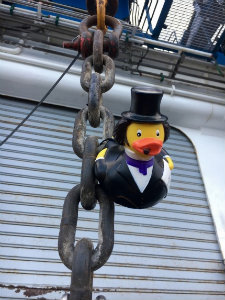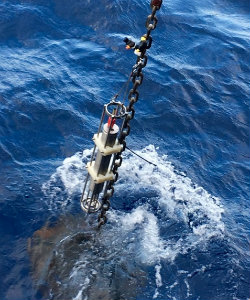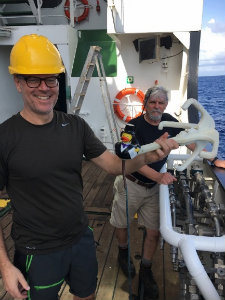I have been at sea for over 3 weeks now and have seen very little of anything beyond the ship. As our internet connection is barely working, I am feeling a bit cut off from the outside world. In contrast, I have never been so aware of my immediate surroundings. We are constantly monitoring things like: geographical position; water depth and the nature of the seafloor; temperature of the air and sea surface; air pressure and humidity; relative and absolute wind speed and direction; ship speed and bearing; any evidence of other ships in the area; wave effects, including pitch, roll and heave; ETA to our next waypoint; sunrise and sunset; and even cable length, speed and tension, if a winch is working.
On breaks, I spend a lot of time watching the sea (… or watching episodes of ‘The Office’). My shift starts at 5am, so I see the sun rise every day (07:15), and most people go out to watch the sunset after dinner (19:15). We have seen a few fishing ships and tankers, but also saw the French research ship, the ‘Pourquoi Pas ?”. On a good day, from the Bridge you can see roughly 12 NM or over 22 km.
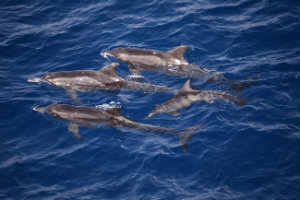 Any sighting of animals is exciting. On the way south, near the Cape Verde Islands, we often saw turtles. A few birds have been seen and one was even a stowaway for a few days. Flying fish are ubiquitous. A few whales have been spotted, including a pod of pilot whales, one of which came very close to an OBS on the surface. They may have been attracted to the ‘chirping’ noise from the acoustic signal.
Any sighting of animals is exciting. On the way south, near the Cape Verde Islands, we often saw turtles. A few birds have been seen and one was even a stowaway for a few days. Flying fish are ubiquitous. A few whales have been spotted, including a pod of pilot whales, one of which came very close to an OBS on the surface. They may have been attracted to the ‘chirping’ noise from the acoustic signal.
Dolphins are great fun to watch. We have seen them racing the ship off the front bow, playing in the surf. Today we saw 40-50 frolicking in front of the ship, while we were stationary trying to communicate with an OBS on the seafloor. Their clicking and squeaking 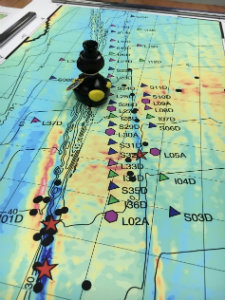 was clearly audible from the acoustic box in the main lab.
was clearly audible from the acoustic box in the main lab.
At night time, when we are running the sound velocity profiler (SVP) off the winch, squid and fish are attracted to the lights. We have seen squid up to a metre in length.
But, probably the most common sighting is a duck. The Brunel duck is the mascot of the Bristol Geophysics Group and helps with field work wherever we go. It has played a key role in navigation, marking our progress across the instrument array. Not content with this function, the duck volunteered to help with the SVP survey. A pinhole was drilled in its tail – a pintail duck, perhaps – and the duck was tie-wrapped to the SVP. It travelled to a depth of 1000m and returned unscathed. The duck also helped retrieve one of the magnetotelluric instruments – here is it attached to the grappling hook.
